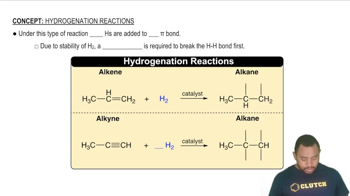Argon has a normal boiling point of 87.2 K and a melting point (at 1 atm) of 84.1 K. Its critical temperature is 150.8 K and its critical pressure is 48.3 atm. It has a triple point at 83.7 K and 0.68 atm. Sketch the phase diagram for argon. Which has the greater density, solid argon or liquid argon?
Ch.12 - Liquids, Solids & Intermolecular Forces

Chapter 12, Problem 79
Water has a high boiling point given its relatively low molar mass. Why?
 Verified step by step guidance
Verified step by step guidance1
Identify the key property of water that contributes to its high boiling point: hydrogen bonding.
Explain that water molecules are polar, with a partial negative charge on the oxygen atom and a partial positive charge on the hydrogen atoms.
Describe how the polarity of water molecules leads to hydrogen bonding, where the hydrogen atom of one water molecule is attracted to the oxygen atom of another water molecule.
Discuss how hydrogen bonds are relatively strong intermolecular forces compared to other types of van der Waals forces, such as London dispersion forces or dipole-dipole interactions.
Conclude that the presence of these strong hydrogen bonds requires more energy (in the form of heat) to break, resulting in a higher boiling point for water compared to other molecules of similar molar mass.
Key Concepts
Here are the essential concepts you must grasp in order to answer the question correctly.
Hydrogen Bonding
Hydrogen bonding is a strong type of dipole-dipole interaction that occurs between molecules when hydrogen is covalently bonded to highly electronegative atoms like oxygen. In water, each molecule can form up to four hydrogen bonds with neighboring molecules, creating a network that requires significant energy to break. This strong intermolecular force contributes to water's high boiling point despite its low molar mass.
Recommended video:
Guided course

Hydrogenation Reactions
Molar Mass vs. Boiling Point
Molar mass is the mass of one mole of a substance, typically influencing boiling points due to the size and weight of molecules. However, boiling points are also significantly affected by intermolecular forces. In the case of water, its relatively low molar mass is offset by the strong hydrogen bonds, resulting in a higher boiling point than expected based solely on molar mass.
Recommended video:
Guided course

Boiling Point Elevation
Intermolecular Forces
Intermolecular forces are the forces of attraction or repulsion between neighboring particles (atoms, molecules, or ions). These forces determine the physical properties of substances, including boiling and melting points. In water, the predominant intermolecular force is hydrogen bonding, which is much stronger than the van der Waals forces present in many other substances, leading to its unusually high boiling point.
Recommended video:
Guided course

Intermolecular vs Intramolecular Forces
Related Practice
Textbook Question
Textbook Question
The phase diagram for sulfur is shown here. The rhombic and monoclinic states are two solid states with different structures. a. Below what pressure does solid sulfur sublime?
Textbook Question
The phase diagram for sulfur is shown here. The rhombic and monoclinic states are two solid states with different structures. b. Which of the two solid states of sulfur is more dense?
Textbook Question
Water is a good solvent for many substances. What is the molecular basis for this property, and why is it significant?
